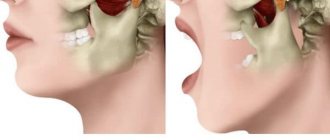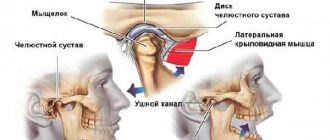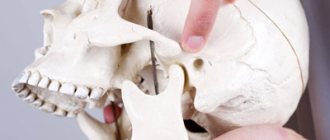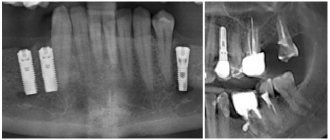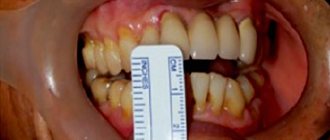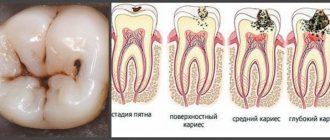11074
Malocclusion is a fairly common phenomenon that can be confidently interpreted as a diagnosis.
These are not only external defects of the maxillofacial apparatus, but also pathologies that cause certain harm to human health.
At the same time, there are often cases when the harm goes beyond the dental framework - difficulty chewing food leads to dysfunction of the gastric system.
One of these bite deviations is a pronounced defect in the development of the jaw. It manifests itself both in its size and in insufficient width or fragmented crowding of the dentition.
Definition of the concept
In orthodontic dentistry, the concept of a small lower jaw has two definitions. Despite the common name, these are completely different pathologies.
Micrognathia
Micrognathia is an anomaly characterized by insufficient development of the jaw in accordance with physiological norms.
Micrognathia can be either general or unilateral. In the second case, changes are observed only in one of the lateral sections.
Prognathia
With prognathia, we are talking about a malocclusion, which is characterized by excessive growth of the upper jaw and, as a result, its protrusion forward.
This creates a visual impression that the lower jaw is small and does not meet the required parameters.
Definition
The concept of “small lower jaw” in orthodontics is not clearly defined.
This diagnosis is classified into several types, differing in the clinical picture of the anomaly.
Micrognathia
Mandibular micrognathia is a defective or too long-term development of an organ that goes beyond the norm.
The defect can affect both the entire jaw and its individual areas, for example, affecting only one lateral part.
Prognathia
It is considered a phenomenon directly opposite to the case described above.
The organ corresponds to the normal parameters, but with the pronounced size of the upper jaw, it seems that it is too small.
Experts often call this disease false prognathia.
Signs
A defect in the lower jaw is easy to determine visually, and you do not need to have the appropriate education to do this.
Pathology represents a serious aesthetic problem, since, first of all, the proportions of the face suffer.
Main signs of deformation:
- Vertical displacement of the chin back. In this condition, it is very common to experience wrinkling of the skin in the lower part of the face and at the same time a smoothing of the horizontal fold between the lip and chin.
- Deformation of individual areas of the dentition. This may be crowding of teeth or, conversely, a change in the direction of their growth in the absence of individual elements.
- may come into contact with the cutting part of the upper jaw teeth.
- In childhood, the pathology can manifest itself as a recession of the lower lip and chin. In particularly difficult cases, this prevents normal latching on the pacifier.
- Malocclusion develops already during the eruption of baby teeth. Due to lack of space, the baby’s teeth grow outside the jaw row or deviate greatly to the side.
With pronounced pathology, patients experience impaired chewing function and difficulty eating solid food.
What does modern medicine offer?
Malocclusion is a fairly common phenomenon that can be confidently interpreted as a diagnosis.
These are not only external defects of the maxillofacial apparatus, but also pathologies that cause certain harm to human health.
At the same time, there are often cases when the harm goes beyond the dental framework - difficulty chewing food leads to dysfunction of the gastric system.
One of these bite deviations is a pronounced defect in the development of the jaw. It manifests itself both in its size and in insufficient width or fragmented crowding of the dentition.
This disorder is treatable. The choice of specific treatment tactics depends on the diagnostic results and the characteristics of the patient’s condition.
Derichsweiler apparatus for jaw correction
- treatment by an orthodontist aimed at reducing the rate of jaw growth, correcting the bite and preventing tooth loss;
- the hardware-surgical method involves correcting the shape of the jaw with surgical instruments and preventing the re-development of the pathology using hardware;
- The combined use of orthognathic surgery and prosthetics makes it possible to completely restore chewing function in lower macrognathia and relieve increased load on the periodontium, for which doctors use braces, dental plates and other orthodontic equipment.
Over more than two million years, the size of teeth gradually decreased due to the transition to eating soft and processed foods. The first transformations affected the fangs - in primates they were larger and more strongly advanced relative to the rest of the row. The interdental spaces have disappeared, the size of the front teeth has become smaller.
Causes
Micrognathia can be either congenital or acquired. Moreover, the first clinical manifestations can appear not only in childhood, but also in adulthood under the influence of a variety of factors.
The main cause of a birth defect in a child is an intratubal disruption of the process of establishing the correct ratio of the sizes of both jaws.
Provoking factors include:
- heredity, genetic predisposition;
- errors in the nutrition of a pregnant woman;
- severe acute respiratory infections during pregnancy;
- alcohol abuse, smoking.
As for the acquired form of micrognathia, the main reasons for the development of anomalies in children:
- early loss of baby teeth against the background of late eruption of molars;
- premature loss (extraction) of baby teeth;
- mouth breathing (chronic nasal congestion that interferes with normal respiratory function);
- endocrine diseases;
- bad habits (extra objects in the mouth, sucking a pacifier, etc.);
- improper feeding.
Refusal of orthodontic therapy for primary occlusion only aggravates the situation, and the severity of the pathology increases with age.
Other reasons for the development of anomalies in adults include:
- maxillofacial injuries accompanied by damage to bone tissue or periodontal tissue;
- overstrain of the muscles of the occipital and cervical region;
- violation of swallowing, chewing or respiratory function;
- bone diseases;
- diabetes;
- metabolic disorder.
Conservative methods of treatment of mandibular fracture and indications for surgical intervention.
Let's talk here about the symptoms of osteomyelitis of the jaw and its treatment.
At this address, all the most important information about mandibular cementoma.
Diagnostic methods
Micrognathia can be detected even at the stage of intrauterine fetal formation. For this purpose, the echography method is used. Also, the presence of deviations in jaw development is indicated by a large volume of amniotic fluid.
In an adult, the disease is diagnosed by external examination of the facial part of the head and collecting information about the clinical manifestations of the pathology. Additionally, an orthopantogram is prescribed.
This method involves taking a panoramic photograph of both jaws, on the basis of which it is possible to establish the nature and characteristics of the anomaly. The data obtained after the orthopantogram will be used to determine the treatment regimen for micrognathia.
Treatment
When choosing a treatment method, the patient’s age is first taken into account. Methods used for children are not relevant for adult patients and vice versa.
The type of anomaly must also be taken into account. If microgenia is an underdeveloped lower jaw, then treatment should be aimed at stimulating its development.
If the problem with the lower jaw is purely visual in nature against the background of an overdeveloped upper part of the jaw apparatus, the main goal of the therapy is to restrain its growth.
Let's look at all the methods in order.
Treatment in children
The most favorable period for correcting malocclusions is considered to be the time before the eruption of permanent teeth. Treatment includes the following stages:
- Sanitation of the oral cavity. This is a whole range of procedures, including restoration of the crown part of baby teeth, removal of damaged roots and treatment of periodontal tissue.
- Prosthetics. In case of premature loss of milk units, it is extremely important to maintain the correct position of the teeth and jaw size. For this purpose, prosthetics with temporary structures or splinting may be proposed.
- Restoration of respiratory or linguistic function. If necessary, the frenulum is trimmed or the nasal septum is corrected. At this stage, a consultation with an otolaryngologist will be required.
- Myogymnastics is the use of special exercises that help normalize the tone of the jaw muscles. At the age of 4 to 7 years, this simple procedure helps to completely restore the size of the jaw without the use of orthodontic structures.
- Grinding of fissures - according to indications.
- Orthodontic treatment , wearing mouthguards, plates. It is used for pronounced pathologies of the lower jaw.
Important! A mandatory component of treatment is giving up bad habits.
Treatment in adults
The decision regarding surgical treatment is made only after the doctor is convinced that it is impossible to use orthodontic structures.
There are several methods for correcting malocclusion, each of which has its own advantages and disadvantages.
Bone grafting
The essence of the procedure is the artificial growth of bone tissue:
- During the operation, several incisions are made in the lower jaw, after which the bone is moved apart, and the vacant areas are filled with bone material.
- The transplanted fragments are fixed with titanium screws.
- Intermediate voids are filled with plastic chips, which have a porous structure for the full germination of blood vessels and the migration of osteoblasts (young bone cells).
- After this, the jaw at the incision sites is sutured.
The main advantage of bone grafting is the rapid survival of the transplanted material.
The jaw heals quickly after the procedure, maintaining its functionality for a long time.
The disadvantages of this surgical treatment include possible intolerance to the components used to fix the bone material.
Bone grafting and liposculpture
The nature of the surgical intervention is similar to the method described above. In addition to this, vacuum suction is performed of adipose tissue accumulated in this area.
The procedure allows you to solve not only the functional problem of the anomaly, but also fulfills a number of aesthetic purposes, including correction of the shape of the face.
And if the achieved cosmetic effect is one of the main advantages of the method, then the high cost of the procedure is the main disadvantage.
See photos of malocclusion and learn about methods for correcting abnormalities.
In this article we will tell you why your jaw clicks when chewing and how to fix it.
Follow the link if you are interested in methods of treating submandibular lymphadenitis.
Endoprosthetics
The essence of the method is the implantation of facial implants made of silicone or other artificial materials.
During the operation, deep incisions are made on the mucous membrane, through which implants are inserted into the chin area. Already “in place” the material is given the desired shape, after which it is fixed with the help of surgical threads.
The main advantage is that the procedure is performed inside the oral cavity and, as a result, there are no visible marks after the operation .
But, unfortunately, the use of non-biological materials significantly increases the duration of the rehabilitation period.
Lipofilling
Lipofilling refers to non-surgical correction methods without direct intervention in the structure of bone tissue. In this option we are talking about increasing the chin in the required area.
During the procedure, adipose tissue is injected under the skin using a special needle , filling individual areas.
Since the method is essentially cosmetic, it is characterized by a short rehabilitation period and the absence of complications.
But lipofilling also has one significant drawback - the achieved result requires regular correction every 5-6 months.
Malocclusion in a child: identify and correct it in time!
Severe microgenia is easily noticeable, but in the early stages only a specialist will diagnose and determine the anomaly. Underdevelopment of the jaws is visible during ultrasound examination of the fetus.
Pathology of the skull bones is suspected when there is a large amount of amniotic fluid, if during the development of the tongue its deformation did not occur and it does not prevent them from entering the fetal mouth.
Since micrognathia of the lower jaw becomes the cause of much more serious disorders, you should not neglect scheduled visits to the surgeon, as well as observation at the dental clinic.
If microgynia is suspected, the patient is given an orthopantomogram, a panoramic image of the dentofacial apparatus, which the attending physician relies on for further treatment.
We suggest you read: Pain in the neck on the right under the jaw: causes and treatment
Pain in the tongue increases sharply when eating spicy food. The causes of the disease are unknown.
Glossitis is a disease similar to geographic tongue, but unlike the latter, the causes of glossitis are usually known. Glossitis can be caused by infection, injury, allergy (or all three). Glossitis occurs with anemia. Unlike geographic tongue, glossitis covers the entire tongue with inflammation (without spotty exceptions).
Pain in the tongue is a symptom of tongue ulceration. Pain may also be caused by constant biting of the tongue when performing chewing movements. The reason for this phenomenon is diseased, improperly growing teeth or poorly fitting dentures.
What to do. Getting rid of a sore tongue requires a lot of patience. In most cases, it goes away without treatment, causing only worry; To do this, it is enough to abstain from spicy and hot food, alcohol and tobacco for several days, and take care of your health.
If, however, the pain in the tongue continues for 10 days or longer, then you need to see a doctor. If he finds that the cause of the pain is a disease, such as an infection or poor diet, he will prescribe treatment. With successful treatment, the symptom will completely disappear.
Associated symptoms. If the pain in the tongue is accompanied by swelling and does not go away for a long time, then you should consult a doctor.
Ulcers on the tongue, in the mouth
←Face, Jaws, Mouth→Taste disordersSearch Lectures
Prices
In each specific case, the cost of treatment is determined individually. This will depend on the nature of the anomaly, the scope of dental treatment and the qualifications of the clinic.
Approximate cost of dental treatment of primary teeth in children:
| Service | Price in rubles |
| Sanitation of the oral cavity | 3 000—4 500 |
| Orthopedic treatment | from 25,000—30,000 |
| Fissure grinding | from 10 000 |
| Surgery | from 16 000 |
Average prices for correction of the size of the lower jaw in adults:
| Service | Price in rubles |
| Bone grafting | from 20 000 |
| Bone grafting and liposculpture | from 45 000 |
| Endoprosthetics | from 35 000 |
| Lipofilling | From 30 000 |
Possible consequences
In addition to the aesthetic aspect, underdevelopment of the lower jaw can cause serious harm to a person’s health. The following problems may occur:
- malocclusion;
- disruption of the auditory and respiratory organs;
- persistent problems with chewing and swallowing, which ultimately leads to problems in the gastrointestinal tract;
- the absence of some teeth and deformation of existing ones;
- weakening of the immune system in general, and, as a result, frequent illnesses.
For adults, the treatment process may take longer. If microgenia is congenital, then it is necessary to contact a professional as soon as possible.
Prevention
It is very easy to avoid the possible development of an anomaly. To do this, you just need to follow some recommendations:
- Don't give up breastfeeding your newborn baby. If you are forced to use mixtures, make sure you select the correct nipple on the bottle. The same applies to pacifiers.
- Visit your dentist regularly and, if necessary, undergo timely treatment.
- Fight bad habits in your baby.
- Do not develop a runny nose or other illnesses that interfere with normal nasal breathing.
- Be sure to consult an orthodontist if you are losing baby teeth prematurely.
The video shows a surgical treatment plan for the anomaly.
A small lower jaw is a cosmetic defect or a serious pathology
What malocclusions are encountered in dental practice? And a small lower jaw is not uncommon.
Such a defect is not only an aesthetic problem, but also serious risks for the health of the entire body.
What prevents the normal development of bone tissue, and what can cause this disease? Let's try to sort out all these questions today.
The content of the article:
Reviews
Have you ever had to deal with malocclusion? Maybe one of your relatives was diagnosed with a small lower jaw? Leave your feedback about the treatment in the comments.
If you find an error, please select a piece of text and press Ctrl+Enter.
tags small lower jaw jaw
Did you like the article? stay tuned
Description of the term
In orthodontics, there is such a thing as micrognathia, which is literally translated from Greek as “small jaw” and is underdevelopment of the upper or lower jaw. The opposite concept is macrognathia, in which the jaw is large in size compared to normal.
Abnormal development of the lower jaw is called microgenia. Such disturbances in the development of the masticatory apparatus contribute to uneven tooth growth and the formation of malocclusion. In some cases, crowns may protrude beyond the teeth’s growth line or be completely absent. The upper jaw has normal development.
